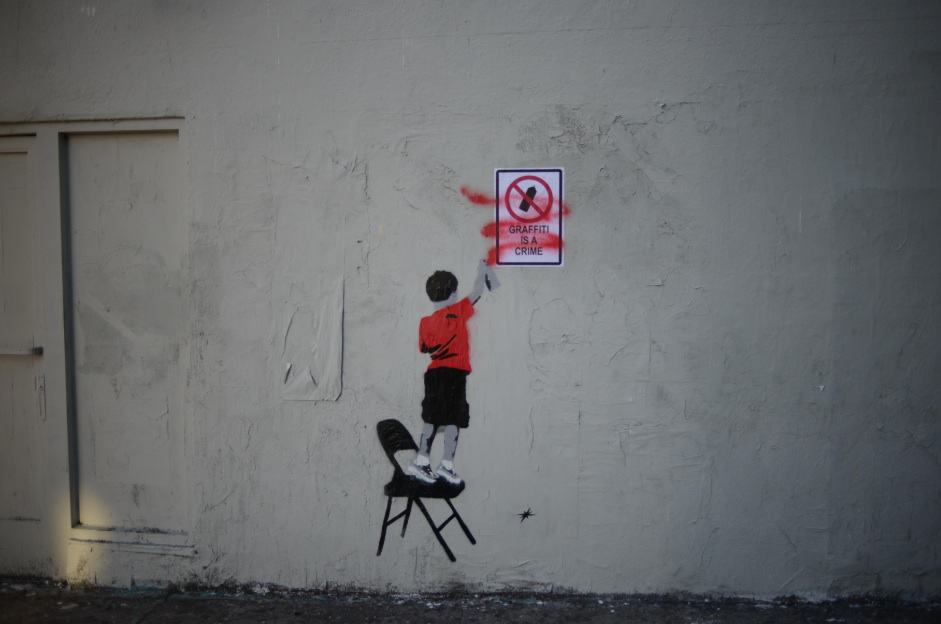“My art is my attempt to connect people with socially important issues that are often overlooked by mainstream media…” Plastic Jesus
Plastic Jesus is a Los Angeles based street artist that specialises in bold stencil and installation work, inspired by world news events, society, the urban environment, culture and politics. His work combines humour, irony, criticism and unique opinion to create art that engages on many levels. In early 2013 his pieces “No more heroes” featuring disgraced cyclist Lance Armstrong connected to an IV drip caught the world’s attention and was featured by many media organisations including CNN, the BBC, The Daily Mail, Huffington post and LA Weekly. Many other pieces have gone viral on the internet and news media including his August 2013 “Best Buys Useless Plastic Box 1.2″.
The Huffington Post listed two works by Plastic Jesus in the end of year round up of “The Best of Los Angeles Street art 2012” Influential street art blog ‘Melrose & fairfax‘ described Plastic Jesus as “The Banksy of LA”. ‘Complex Art-Design’ listed Plastic Jesus as the “#1 LA street artist to watch”. Plastic Jesus is not about revolution, he is not a complete anarchist but would like to see some changes around the place. His work is more about shining a small light into some of those dark corners of society, then standing back and watching reactions and opinions. His work has been featured by The BBC, CNN, abc News, Huffington Post, Gizmodo, Buzzfeed, The Sun, The Daily Mirror, LA Times, LA Weekly, The Daily Mail, MSNBC, The Daily Telegraph, and many more. Plastic Jesus tries to work as ethically as possible and minimise harm to the environment.
THC: What inspires you and why?
PJ: I’m inspired by many issues including news, current affairs and culture. I’ve been a photojournalist for over 20 years and travelled the world covering major stories including conflict, crime, earthquakes, and human rights issue. I met people whose lives have been destroyed often by means that are completely out of their own control. My art is my attempt to connect people with socially important issues that are often overlooked by mainstream media, issues including homelessness, drug use, debt and children in war-zones. I also feel my art is a good way to focus on cultural issues like inequality, the cult of celebrity and corruption.
THC: How did you get into your business?
PJ: My art started connecting with people straight away, so I was very quickly picked up by Walton Fine Arts gallery in London. Prior to my work as a street artist I’ve worked freelance and run my own media agency to try to use what I’ve learned in previous businesses and use that to enhance my art. Some people are critical of street artists who collaborate with Galleries to sell their work. However I’m not a complete anarchist or subversive and in most professions if you are good it’s normally acceptable to get paid to do what you do. Street art should be no different. I’m careful to ensure that all my work is inspired by a true belief that I’m passionate about and not produced just to satisfy galleries or art buyers.
THC: What are you working on right now?
PJ: I’ve always got a few ideas bouncing around my head. Currently I’m working on a piece highlighting fraud by the major banks… Another piece questioning the over-photoshopped images we are fed and brainwashed into believing that this is the definition of beauty. An old favourite of mine is drug use in society. So many people use recreation drugs every weekend or even every day, but it is the elephant in the room. Whilst people are comfortable talking about how much alcohol they consumed at the weekend and how it left them feeling, drugs are still an unspoken taboo.
THC: How do you see your space evolving?
PJ: I’ve just moved into a new space, a 1000ft studio in downtown Los Angeles. The interesting thing about an artist’s studio is that it is constantly evolving, no two days are the same there. A studio also is like a diary or journal, it records the journey an artist goes through when producing art.
THC: Who’s your hero or icon?
PJ: I have heroes from a number of fields. Like many street artists, I hold Banksy up as being the single most important artist in the field. Whether you like his work and persona or not you can’t deny he has done more to bring street art to the mainstream than any other artist. I admire the late Steve Jobs, a true visionary, both in technical sense and marketing sense. Robert Capa, the iconic war photographer was probably the first person who made me realise the importance of an image to convey a message.
THC: Where’s your favourite spot around the world?
PJ: I love traveling and due to my work as a photojournalist I’ve been fortunate enough to visit over 60 countries, I love living in LA but only remained sane because I get out of town pretty often. I found Cambodia fascinating when I visited in 2012, but equally Big Sky Montana is possibly the most beautiful place I’ve visited.
THC: What’s your favourite injection of culture into a brand?
PJ: As an artist I’m very aware of culture aligning with brands. I find it incredibly interesting how a brand can actually affect culture purely with marketing. Take McDonald’s for example – they change the eating habits of the world, or on a more negative level the way some pharmaceutical companies almost ‘create’ conditions in order to ‘ find a cure’. My favourite injection of culture into a brand is currently the way some vehicle manufacturers are turning the desire for a cleaner environment into a marketing strategy for their brand the Nissan Leaf or Chevy Volt are great examples of this. However I don’t buy the idea that if you ‘buy this car you’ll save the planet’, surely not buying the car would have a greater effects on saving the planet?









